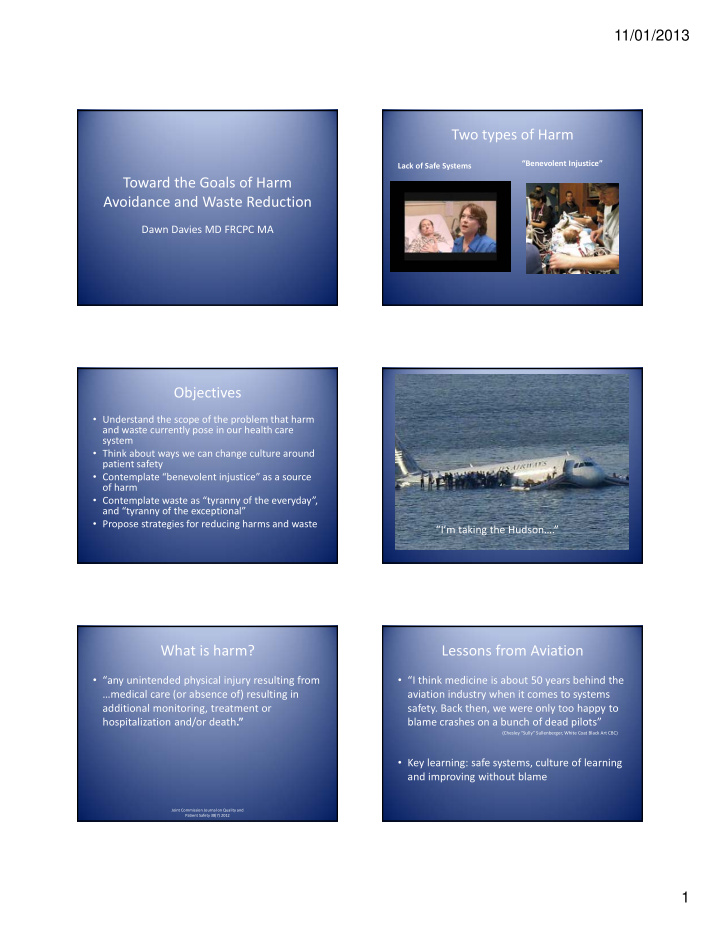



11/01/2013 Two types of Harm “Benevolent Injustice” Lack of Safe Systems Toward the Goals of Harm Avoidance and Waste Reduction Dawn Davies MD FRCPC MA Objectives • Understand the scope of the problem that harm and waste currently pose in our health care system • Think about ways we can change culture around patient safety • Contemplate “benevolent injustice” as a source of harm Lessons from the Aviation • Contemplate waste as “tyranny of the everyday”, and “tyranny of the exceptional” Industry • Propose strategies for reducing harms and waste “I’m taking the Hudson….” What is harm? Lessons from Aviation • “any unintended physical injury resulting from • “I think medicine is about 50 years behind the …medical care (or absence of) resulting in aviation industry when it comes to systems additional monitoring, treatment or safety. Back then, we were only too happy to hospitalization and/or death .” blame crashes on a bunch of dead pilots” (Chesley “Sully” Sullenberger, White Coat Black Art CBC) • Key learning: safe systems, culture of learning and improving without blame Joint Commission Journal on Quality and Patient Safety 38(7) 2012 1
11/01/2013 1977 Tenerife Disaster KLM Boeing 747 crashes on take ‐ off into taxiing jet 583 dead Strict authority hierarchy (crew) Communication barrier Non ‐ standard radio communication Your reflexes seem pretty good, Mr. Hart! Beginning of transformation of aviation, starting with Your reflexes seem pretty good, Mr. “crew resource management” Hart! (Haerkens M et al. Crew resource management in the ICU…Annals of Intensive Care 2012) How are patients harmed Crew resource management (preventable error) • Team roles • Hospital Acquired infections: 5% of all • Effective checklists inpatients, a leading cause of illness/death (Srinivasan A. CDC 2009) • Actual ICU video footage (black box) • Surgical site infections 1) short, clear non ‐ blaming: “Doctor, I’m not • Central line infection death (=breast cancer death rate) sure we did all the checks.” • Ventilator associated pneumonia 2) key word to add value: “Doctor, I’m not • “superbugs” MRSA, C difficile comfortable with that decision.” • These can be greatly reduced when senior leaders target rate 3) Last resort: “Stop the procedure.” ( Haerkens et al. of zero percent (Waters HR. Am J Med Qual 2011) 2012) Scope Harm • “To Err is Human” (1999) IOM • Medication Errors: • More in children, increased risk from weight ‐ based dosing • 44,000 ‐ 98,000 deaths from medical error annually USA (4,000 ‐ 10,000 Canada?) • Off label use with no dosing guidelines error in calculation • Junior learners with inexperience in treating children • Few jumbo jets a week without senior supervision (Wong ICK. Arch Dis Child 2009) • Guns don’t kill people…. 2
11/01/2013 Why? Waste • Financial waste in the system estimate to be • Cognitive errors: normalcy bias; confirmation 30 ‐ 50% of all health care system costs (still bias; anchoring; preserving all beneficial treatment to all) • Complexity: multiple specialists, medications 1/3 behavioral issues • Paper orders 1/3 clinical inefficiencies • Communication Failure 1/3 operational efficiencies (Brody H. NEJM 366;21:May 24, 2012 PricewaterhouseCoopers’ HRI 2011 James B. HarperBusiness 2011) Benevolent Injustice Tyranny of the Everyday • Beauchamp and Childress: “promoting the • CBC welfare of patients ‐ not merely avoiding harm ‐ • Virtually every emergency and hospital expresses medicine’s goal, rationale, and admission, periodic justification.” (Principles of Biomedical Ethics 5 th Ed.) health exams • Cost: $17 ‐ 24 ($20), with all staff costs, could be • Well ‐ intentioned treatment results in $200 X 700,000= unintended harm (neurological debilitation or • $14 M ‐ $140 M/ year technological dependence) Evolution of Benevolent Injustice Tyranny of the Exceptional • Poor prognostication • Baby V: multiple anatomical abnormalities of bladder/pelvis/hips/ intestines/genitalia • Developed chronic lung disease; trach/vent • Overtreatment • Young parents insist continually “everything done”; multiple surgeries • Acquiescing to parental/SDM demands • Lived till one year NICU, then PICU till institutionalized. Parents withdraw from her. (Catlin A. Advances in newborn care 2009). Deaf, non ‐ verbal, no clear interaction with env. Multiple readmissions including PICU, dies at 10 3
11/01/2013 Solutions Systems ‐ based solutions • Simulation (normalcy bias) • Automatic built ‐ in responses from collaboration with engineering: • E.g. main risk of opioid infusions is slowing or stopping of breathing • System solution to have feedback of respiratory slowing to stop pump and alarm (Pronovost PJ JAMA 2012) Simulation Accountability for Reasonableness • Mock “no ‐ code” • Development of Just Processes • Simulation for how to have conversations (Norman Daniels, James Sabin) • More necessary, given preponderance of death due to withdrawing or withholding certain non ‐ beneficial therapies, including resuscitation A for R • Green Light (clinical, operational and financial expert leaders collaborate with plan to 1)Broad spectrum group from organization, improve safety) (Denham CR et al. J Patient Saf Sept 2012) patients, and the public 2) Processes that are transparent with regard to the • Top Five List : charge each specialty with decision making activities evaluating top five tests re: frequency and 3) Robust appeals process that allows response to expense, figure out how to prescribe based on further evidence or arguments evidence to curb non ‐ beneficial use (e.g. 4) Develop institutional accountability to ensure overuse of CT scans) (Brody H NEJM 2009) the first three steps are actually followed. (Jennifer Gibson, Douglas Martin, Peter Singer. BMC Health Services Research. 2002) 4
11/01/2013 “The myth that physicians are innocent bystanders merely watching health care costs zoom out of control cannot be sustained.” (Brody H. NEJM 2010) Societal Engagement • Ought the provision of medical treatment be our major expenditure on “health” when we know social determinants (education, nutrition, poverty) are much more important at population level? • If the goals of medicine are to alleviate suffering and/or restore health, have we inadvertently strayed in facilitating chronic critical illness, in which neither aim is realized ? 5
Recommend
More recommend